Precipitation Microphysics during the Extreme Meiyu Period in 2020
Abstract
:1. Introduction
2. Data and Methods
2.1. Datasets
2.2. Methods
3. Results
3.1. Horizontal Distribution and Diurnal Variation
3.2. Vertical Structure and Microphysics
4. Discussion
5. Conclusions
Author Contributions
Funding
Data Availability Statement
Conflicts of Interest
References
- Wu, Z.; Wang, B.; Li, J.; Jin, F. An empirical seasonal prediction model of the east Asian summer monsoon using ENSO and NAO. J. Geophys. Res. Atmos. 2009, 114, D18120. [Google Scholar] [CrossRef]
- Sampe, T.; Xie, S. Large-Scale Dynamics of the Meiyu-Baiu Rainband: Environmental Forcing by the Westerly Jet. J. Clim. 2010, 23, 113–134. [Google Scholar] [CrossRef] [Green Version]
- Xu, X.; Lu, C.; Shi, X.; Ding, Y. Large-scale topography of China: A factor for the seasonal progression of the Meiyu rainband? J. Geophys. Res. Atmos. 2010, 115. [Google Scholar] [CrossRef]
- Ninomiya, K. Large-and meso-α-scale characteristics of Meiyu/Baiu front associated with intense rainfalls in 1–10 July 1991. J. Meteorol. Soc. Jpn. 2000, 78, 141–157. [Google Scholar] [CrossRef] [Green Version]
- Luo, Y.; Chen, Y. Investigation of the predictability and physical mechanisms of an extreme-rainfall-producing mesoscale convective system along the Meiyu front in East China: An ensemble approach. J. Geophys. Res. Atmos. 2015, 120, 10593–10618. [Google Scholar] [CrossRef]
- Tao, S.Y.; Ding, Y.H. Observational Evidence of the Influence of the Qinghai-Xizang (Tibet) Plateau on the Occurrence of Heavy Rain and Severe Convective Storms in China. Bull. Am. Meteorol. Soc. 1981, 62, 23–30. [Google Scholar] [CrossRef]
- Ge, Q.; Guo, X.; Zheng, J.; Hao, Z. Meiyu in the middle and lower reaches of the Yangtze River since 1736. Chin. Sci. Bull. 2008, 53, 107–114. [Google Scholar] [CrossRef]
- Li, H.; He, S.; Fan, K.; Wang, H. Relationship between the onset date of the Meiyu and the South Asian anticyclone in April and the related mechanisms. Clim. Dyn. 2019, 52, 209–226. [Google Scholar] [CrossRef]
- Park, C.; Son, S.; Kim, H.; Ham, Y.; Kim, J.; Cha, D.; Chang, E.; Lee, G.; Kug, J.; Lee, W.; et al. Record-breaking summer rainfall in South Korea in 2020: Synoptic characteristics and the role of large-scale circulations. Mon. Weather Rev. 2021, 149, 3085–3100. [Google Scholar] [CrossRef]
- Wang, L.; Sun, X.; Yang, X.; Tao, L.; Zhang, Z. Contribution of Water Vapor to the Record-Breaking Extreme Meiyu Rainfall along the Yangtze River Valley in 2020. J. Meteorol. Res. 2021, 35, 557–570. [Google Scholar] [CrossRef]
- Ding, Y.; Liu, Y.; Hu, Z. The Record-breaking Meiyu in 2020 and Associated Atmospheric Circulation and Tropical SST Anomalies. Adv. Atmos. Sci. 2021, 38, 1980–1993. [Google Scholar] [CrossRef]
- Zhang, L.; Zhao, D.; Zhou, T.; Peng, D.; Xiao, C. Moisture Origins and Transport Processes for the 2020 Yangtze River Valley Record-Breaking Mei-yu Rainfall. Adv. Atmos. Sci. 2021, 38, 2125–2136. [Google Scholar] [CrossRef]
- Liang, P.; Hu, Z.; Ding, Y.; Qian, Q. The Extreme Mei-yu Season in 2020: Role of the Madden-Julian Oscillation and the Cooperative Influence of the Pacific and Indian Oceans. Adv. Atmos. Sci. 2021, 38, 2040–2054. [Google Scholar] [CrossRef]
- Pang, Z.; Shi, C.; Gu, J.; Pan, Y.; Xu, B. Assessment of a Gauge-Radar-Satellite Merged Hourly Precipitation Product for Accurately Monitoring the Characteristics of the Super-Strong Meiyu Precipitation over the Yangtze River Basin in 2020. Remote Sens. 2021, 13, 3850. [Google Scholar] [CrossRef]
- Xie, S.; Kosaka, Y.; Du, Y.; Hu, K.; Chowdary, J.S.; Huang, G. Indo-Western Pacific Ocean Capacitor and Coherent Climate Anomalies in Post-ENSO Summer: A Review. Adv. Atmos. Sci. 2016, 33, 411–432. [Google Scholar] [CrossRef] [Green Version]
- Takaya, Y.; Ishikawa, I.; Kobayashi, C.; Endo, H.; Ose, T. Enhanced Meiyu-Baiu Rainfall in Early Summer 2020: Aftermath of the 2019 Super IOD Event. Geophys. Res. Lett. 2020, 47. [Google Scholar] [CrossRef]
- Pan, X.; Li, T.; Sun, Y.; Zhu, Z. Cause of Extreme Heavy and Persistent Rainfall over Yangtze River in Summer 2020. Adv. Atmos. Sci. 2021, 38, 1994–2009. [Google Scholar] [CrossRef]
- Fang, C.; Liu, Y.; Cai, Q.; Song, H. Why Does Extreme Rainfall Occur in Central China during the Summer of 2020 after a Weak El Niño? Adv. Atmos. Sci. 2021, 38, 2067–2081. [Google Scholar] [CrossRef]
- Zhou, Z.; Xie, S.; Zhang, R. Historic Yangtze flooding of 2020 tied to extreme Indian Ocean conditions. Proc. Natl. Acad. Sci. USA 2021, 118, e2022255118. [Google Scholar] [CrossRef]
- Chen, X.; Dai, A.; Wen, Z.; Song, Y. Contributions of Arctic Sea-Ice Loss and East Siberian Atmospheric Blocking to 2020 Record-Breaking Meiyu-Baiu Rainfall. Geophys. Res. Lett. 2021, 48. [Google Scholar] [CrossRef]
- Clark, R.T.; Wu, P.; Zhang, L.; Li, C. The Anomalous Mei-yu Rainfall of Summer 2020 from a Circulation Clustering Perspective: Current and Possible Future Prevalence. Adv. Atmos. Sci. 2021, 38, 2010–2022. [Google Scholar] [CrossRef]
- Horinouchi, T.; Kosaka, Y.; Nakamigawa, H.; Nakamura, H.; Fujikawa, N.; Takayabu, Y.N. Moisture Supply, Jet, and Silk-Road Wave Train Associated with the Prolonged Heavy Rainfall in Kyushu, Japan in Early July 2020. Sola 2021, 17B, 1–8. [Google Scholar] [CrossRef]
- Liu, B.; Yan, Y.; Zhu, C.; Ma, S.; Li, J. Record-Breaking Meiyu Rainfall Around the Yangtze River in 2020 Regulated by the Subseasonal Phase Transition of the North Atlantic Oscillation. Geophys. Res. Lett. 2020, 47. [Google Scholar] [CrossRef]
- Qiao, S.; Chen, D.; Wang, B.; Cheung, H.N.; Liu, F.; Cheng, J.; Tang, S.; Zhang, Z.; Feng, G.; Dong, W. The Longest 2020 Meiyu Season Over the Past 60 Years: Subseasonal Perspective and Its Predictions. Geophys. Res. Lett. 2021, 48. [Google Scholar] [CrossRef]
- Lu, B.; Takaya, Y. Record Meiyu-Baiu of 2020: Reflections for prediction. Sci. Bull. 2021, 66, 1939–1941. [Google Scholar] [CrossRef]
- Bett, P.E.; Martin, G.M.; Dunstone, N.; Scaife, A.A.; Thornton, H.E.; Li, C. Seasonal Rainfall Forecasts for the Yangtze River Basin in the Extreme Summer of 2020. Adv. Atmos. Sci. 2021, 38, 2212–2220. [Google Scholar] [CrossRef]
- Li, C.; Lu, R.; Dunstone, N.; Scaife, A.A.; Bett, P.E.; Zheng, F. The Seasonal Prediction of the Exceptional Yangtze River Rainfall in Summer 2020. Adv. Atmos. Sci. 2021, 38, 2055–2066. [Google Scholar] [CrossRef]
- Hu, Y.; Ding, Y. Simulation of 1991–2005 Meiyu seasons in the Yangtze-Huaihe region using BCC_RegCM 1.0. Chin. Sci. Bull. 2010, 55, 1077–1083. [Google Scholar] [CrossRef]
- Tong, M.; Zheng, Z.; Fu, Q. Characteristics of Meiyu Seen from Multiple Observational Analyses and Reanalyses. Earth Space Sci. 2021, 8. [Google Scholar] [CrossRef]
- Volonté, A.; Muetzelfeldt, M.; Schiemann, R.; Turner, A.G.; Klingaman, N. Magnitude, Scale, and Dynamics of the 2020 Mei-yu Rains and Floods over China. Adv. Atmos. Sci. 2021, 38, 2082–2096. [Google Scholar] [CrossRef]
- Cui, W.; Dong, X.; Xi, B.; Liu, M. Cloud and Precipitation Properties of MCSs Along the Meiyu Frontal Zone in Central and Southern China and Their Associated Large-Scale Environments. J. Geophys. Res. Atmos. 2020, 125. [Google Scholar] [CrossRef]
- Zhang, A.Q.; Chen, Y.L.; Zhou, S.N.; Cui, C.G.; Wan, R.; Fu, Y.F. Diurnal Variation of Meiyu Rainfall in the Yangtze Plain During Atypical Meiyu Years. J. Geophys. Res. Atmos. 2020, 125. [Google Scholar] [CrossRef]
- Chiang, J.C.H.; Swenson, L.M.; Kong, W. Role of seasonal transitions and the westerlies in the interannual variability of the East Asian summer monsoon precipitation. Geophys. Res. Lett. 2017, 44, 3788–3795. [Google Scholar] [CrossRef]
- Wang, P.; Yang, J. Observation and Numerical Simulation of Cloud Physical Processes Associated with Torrential Rain of the Meiyu Front. Adv. Atmos. Sci. 2003, 20, 77–96. [Google Scholar] [CrossRef]
- Yokoyama, C.; Takayabu, Y.N.; Kanada, S. A Contrast in Precipitation Characteristics across the Baiu Front near Japan. Part I: TRMM PR Observation. J. Clim. 2014, 27, 5872–5890. [Google Scholar] [CrossRef]
- Chen, G.; Zhao, K.; Wen, L.; Wang, M.; Huang, H.; Wang, M.; Yang, Z.; Zhang, G.; Zhang, P.; Lee, W. Microphysical Characteristics of Three Convective Events with Intense Rainfall Observed by Polarimetric Radar and Disdrometer in Eastern China. Remote Sens. 2019, 11, 2004. [Google Scholar] [CrossRef] [Green Version]
- Wen, L.; Zhao, K.; Yang, Z.; Chen, H.; Huang, H.; Chen, G.; Yang, Z. Microphysics of Stratiform and Convective Precipitation During Meiyu Season in Eastern China. J. Geophys. Res. Atmos. 2020, 125. [Google Scholar] [CrossRef]
- Sun, Y.; Dong, X.; Cui, W.; Zhou, Z.; Fu, Z.; Zhou, L.; Deng, Y.; Cui, C. Vertical Structures of Typical Meiyu Precipitation Events Retrieved From GPM-DPR. J. Geophys. Res. Atmos. 2020, 125. [Google Scholar] [CrossRef] [Green Version]
- Iguchi, T.; Seto, S.; Meneghini, R.; Yoshida, N.; Awaka, J.; Le, M.; Chandrasekar, V.; Kubota, T. GPM/DPR Level-2 Algorithm Theoretical Basis Document; NASA Goddard Space Flight Center: Greenbelt, MD, USA, 2010.
- Hou, A.Y.; Kakar, R.K.; Neeck, S.; Azarbarzin, A.A.; Kummerow, C.D.; Kojima, M.; Oki, R.; Nakamura, K.; Iguchi, T. The Global Precipitation Measurement Mission. Bull. Am. Meteorol. Soc. 2014, 95, 701. [Google Scholar] [CrossRef]
- Huffman, G.J.; Bolvin, D.T.; Braithwaite, D.; Hsu, K.; Joyce, R.; Xie, P.; Yoo, S. NASA global precipitation measurement (GPM) integrated multi-satellite retrievals for GPM (IMERG). Algorithm Theor. Basis Doc. (ATBD) Version 2015, 4, 26. [Google Scholar]
- Hersbach, H.; Bell, B.; Berrisford, P.; Hirahara, S.; Horányi, A.; Muñoz Sabater, J.; Nicolas, J.; Peubey, C.; Radu, R.; Schepers, D.; et al. The ERA5 global reanalysis. Q. J. R. Meteorol. Soc. 2020, 146, 1999–2049. [Google Scholar] [CrossRef]
- Zhang, A.; Fu, Y. Life Cycle Effects on the Vertical Structure of Precipitation in East China Measured by Himawari-8 and GPM DPR. Mon. Weather Rev. 2018, 146, 2183–2199. [Google Scholar] [CrossRef]
- Chen, D.; Guo, J.; Yao, D.; Feng, Z.; Lin, Y. Elucidating the Life Cycle of Warm-Season Mesoscale Convective Systems in Eastern China from the Himawari-8 Geostationary Satellite. Remote Sens. 2020, 12, 2307. [Google Scholar] [CrossRef]
- Fu, P.; Zhu, K.; Zhao, K.; Zhou, B.; Xue, M. Role of the Nocturnal Low-level Jet in the Formation of the Morning Precipitation Peak over the Dabie Mountains. Adv. Atmos. Sci. 2018, 36, 15–28. [Google Scholar] [CrossRef]
- Zhu, X.; Wu, Z.; He, J. Anomalous Meiyu onset averaged over the Yangtze River valley. Theor. Appl. Climatol. 2008, 94, 81–95. [Google Scholar] [CrossRef]
- Du, Y.; Rotunno, R. A Simple Analytical Model of the Nocturnal Low-Level Jet over the Great Plains of the United States. J. Atmos. Sci. 2014, 71, 3674–3683. [Google Scholar] [CrossRef]
- Yu, R.; Zhou, T.; Xiong, A.; Zhu, Y.; Li, J. Diurnal variations of summer precipitation over contiguous China. Geophys. Res. Lett. 2007, 34. [Google Scholar] [CrossRef] [Green Version]
- Chen, G.; Sha, W.; Iwasaki, T.; Wen, Z. Diurnal Cycle of a Heavy Rainfall Corridor over East Asia. Mon. Weather Rev. 2017, 145, 3365–3389. [Google Scholar] [CrossRef]
- Xue, M.; Luo, X.; Zhu, K.; Sun, Z.; Fei, J. The Controlling Role of Boundary Layer Inertial Oscillations in Meiyu Frontal Precipitation and Its Diurnal Cycles Over China. J. Geophys. Res. Atmos. 2018, 123, 5090–5115. [Google Scholar] [CrossRef]
- Geng, B.; Yamada, H.; Reddy, K.K.; Uyeda, H.; Fujiyoshi, Y. An Observational Study of the Development of a Rainband on a Meiyu Front Causing Heavy Rainfall in the Downstream Region of the Yangtze River. J. Meteorol. Soc. Jpn. 2004, 82, 1095–1115. [Google Scholar] [CrossRef] [Green Version]
- Kirstetter, P.; Viltard, N.; Gosset, M. An error model for instantaneous satellite rainfall estimates: Evaluation of BRAIN-TMI over West Africa. Q. J. R. Meteorol. Soc. 2013, 139, 894–911. [Google Scholar] [CrossRef]
- Chen, Y.; Zhang, A.; Zhang, Y.; Cui, C.; Wan, R.; Wang, B.; Fu, Y. A Heavy Precipitation Event in the Yangtze River Basin Led by an Eastward Moving Tibetan Plateau Cloud System in the Summer of 2016. J. Geophys. Res. Atmos. 2020, 125. [Google Scholar] [CrossRef]
- Lee, G.W.; Zawadzki, I.; Szyrmer, W.; Sempere-Torres, D.; Uijlenhoet, R. A general approach to double-moment normalization of drop size distributions. J. Appl. Meteorol. 2004, 43, 264–281. [Google Scholar] [CrossRef] [Green Version]
- Bang, W.; Lee, G.; Ryzhkov, A.; Schuur, T.; Sunny Lim, K. Comparison of Microphysical Characteristics between the Southern Korean Peninsula and Oklahoma Using Two-Dimensional Video Disdrometer Data. J. Hydrometeorol. 2020, 21, 2675–2690. [Google Scholar] [CrossRef]
- Kumjian, M.R.; Prat, O.P. The Impact of Raindrop Collisional Processes on the Polarimetric Radar Variables. J. Atmos. Sci. 2014, 71, 3052–3067. [Google Scholar] [CrossRef]
- Porcacchia, L.; Kirstetter, P.E.; Maggioni, V.; Tanelli, S. Investigating the GPM Dual-frequency Precipitation Radar signatures of low-level precipitation enhancement. Q. J. R. Meteorol. Soc. 2019, 145, 3161–3174. [Google Scholar] [CrossRef]
- Huang, H.; Chen, F. Precipitation Microphysics of Tropical Cyclones Over the Western North Pacific Based on GPM DPR Observations: A Preliminary Analysis. J. Geophys. Res. Atmos. 2019, 124, 3124–3142. [Google Scholar] [CrossRef]
- Carr, N.; Kirstetter, P.E.; Gourley, J.J.; Hong, Y. Polarimetric Signatures of Midlatitude Warm-Rain Precipitation Events. J. Appl. Meteorol. Clim. 2017, 56, 697–711. [Google Scholar] [CrossRef]
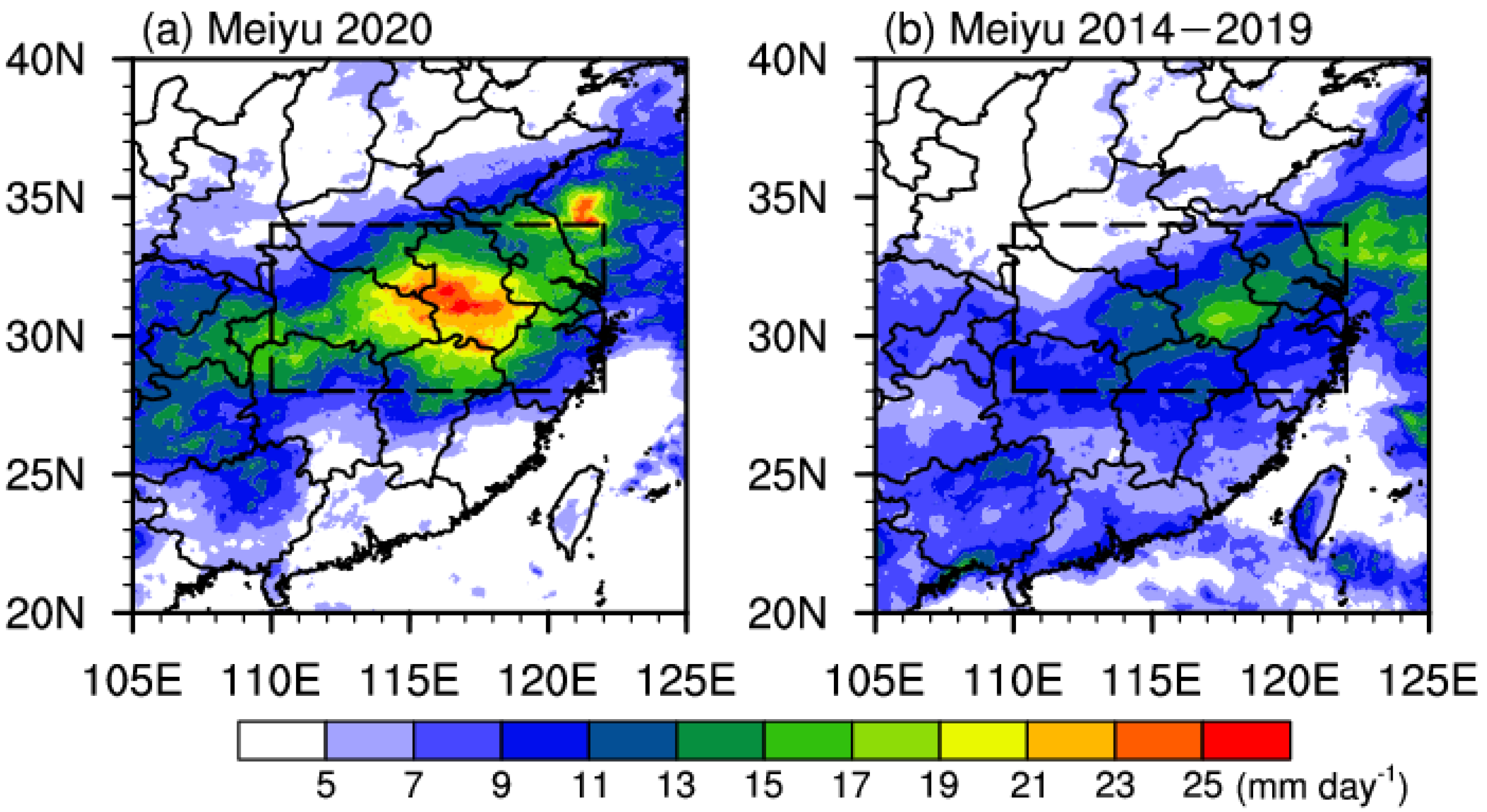
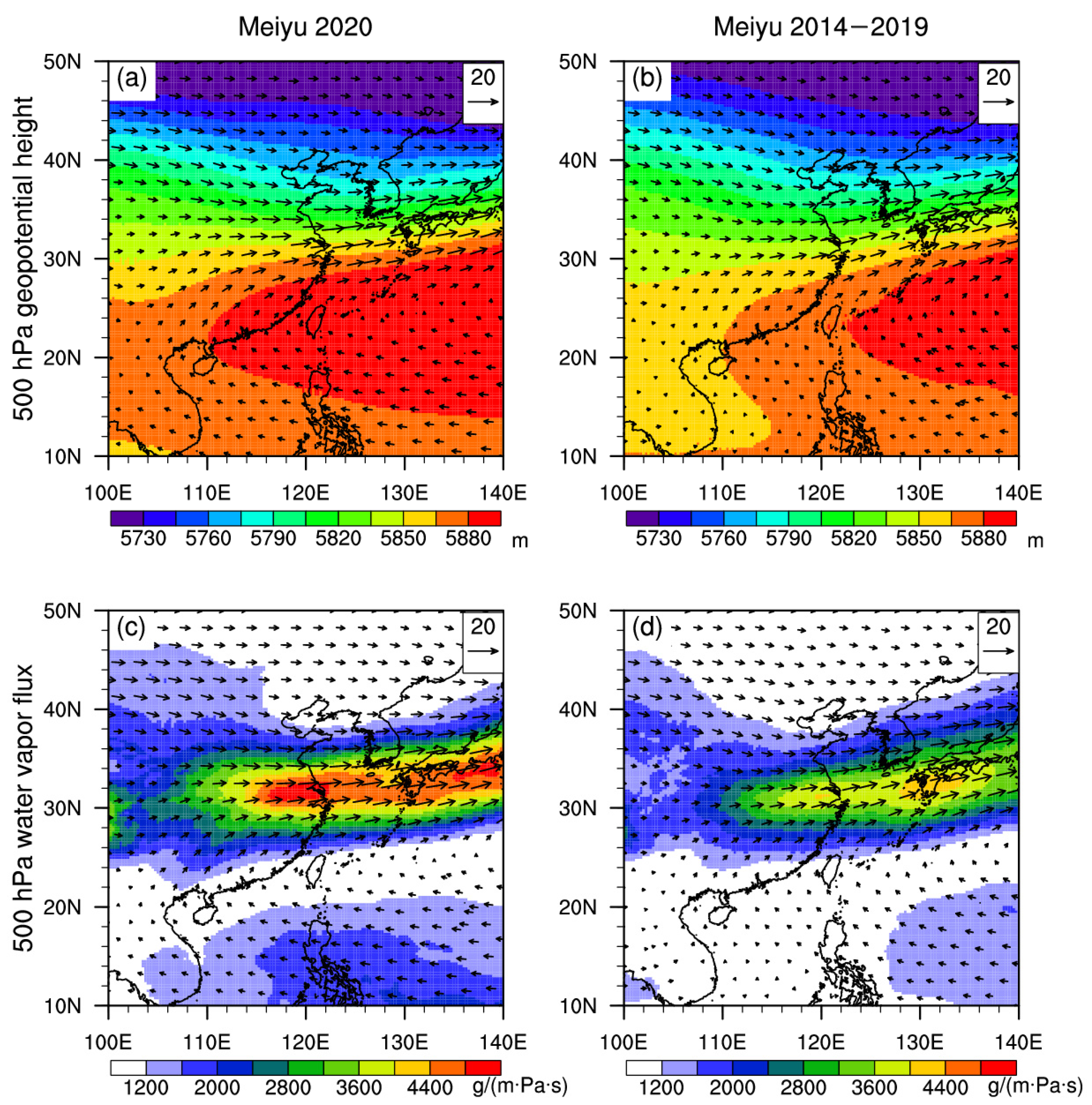
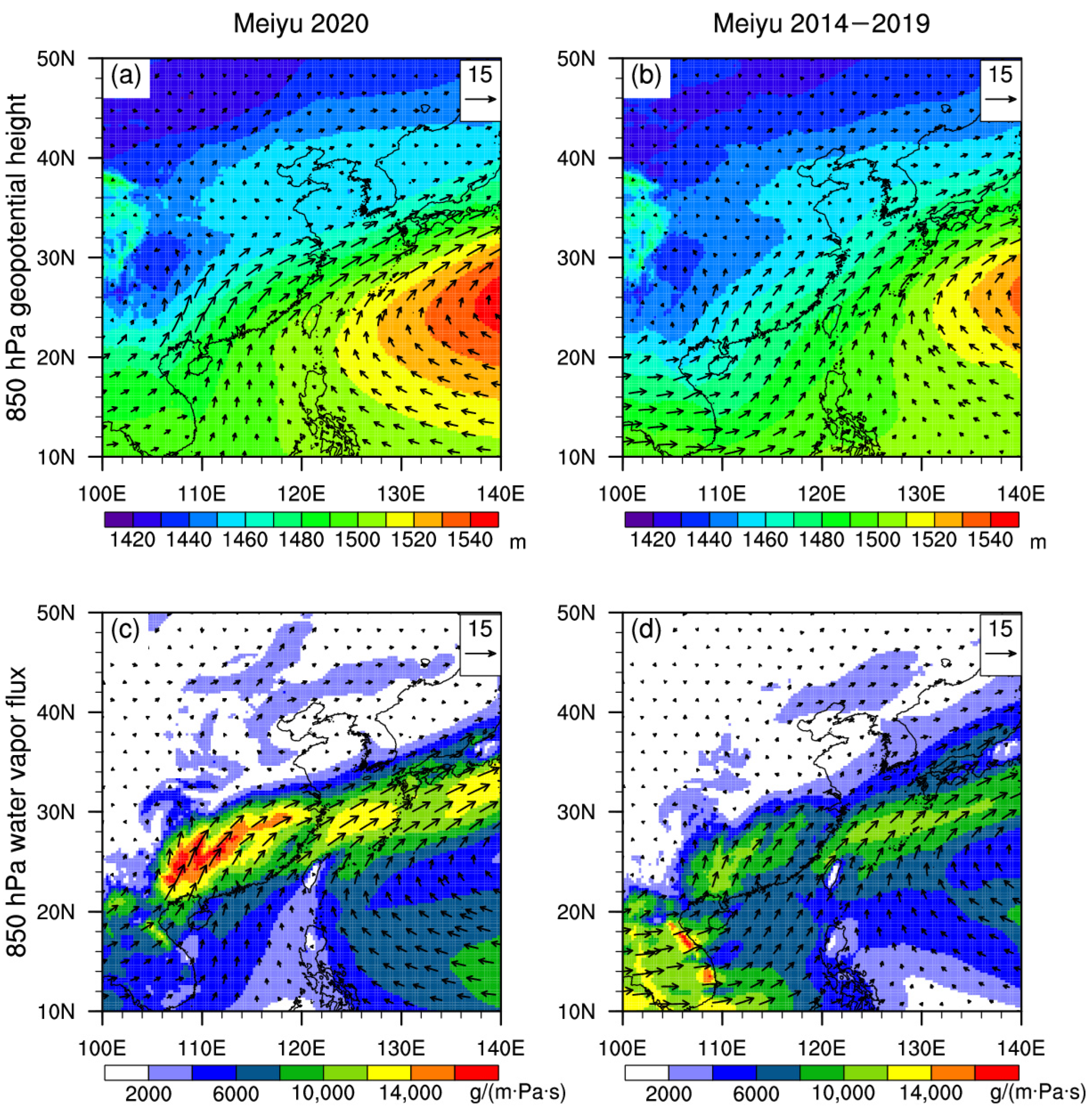
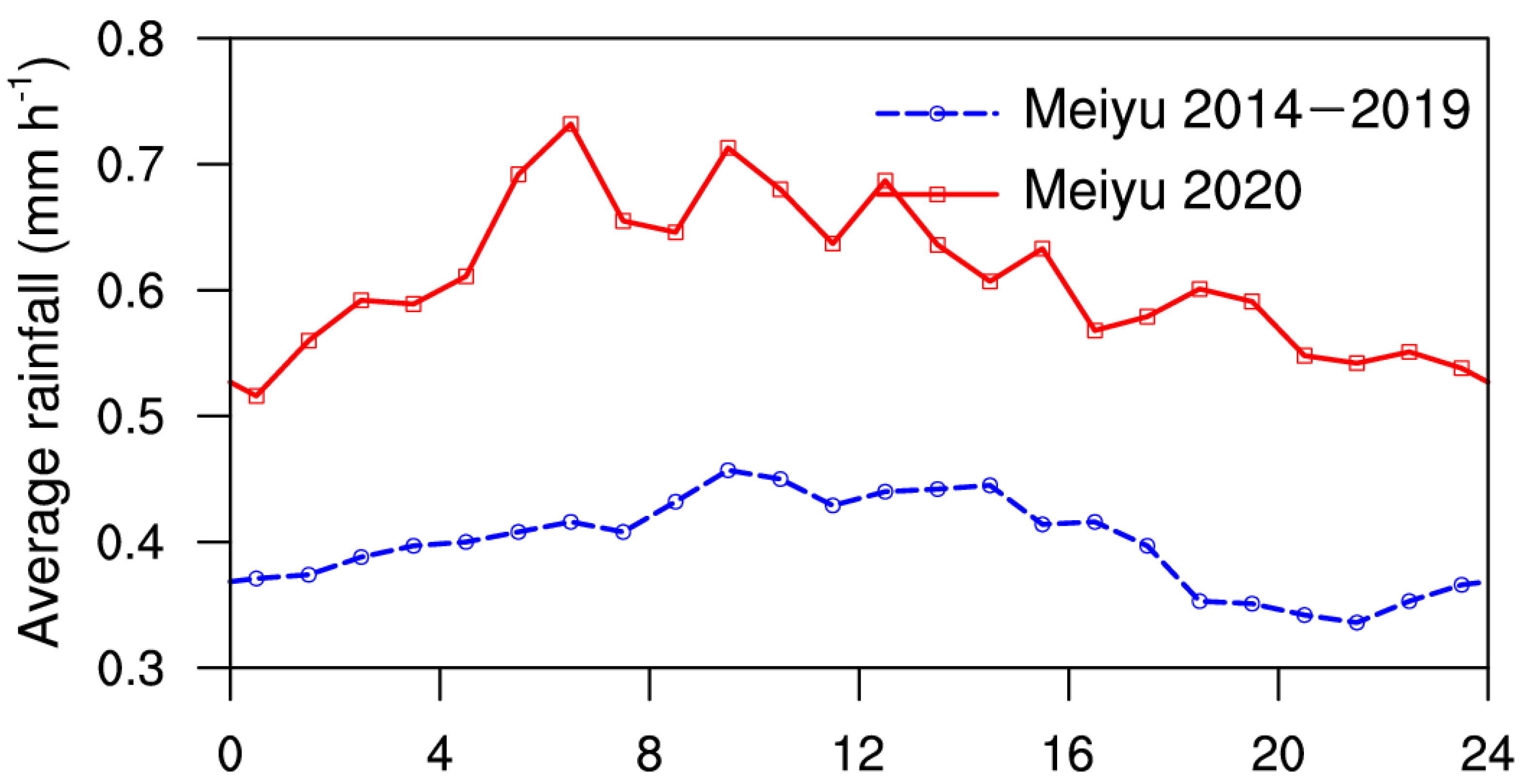

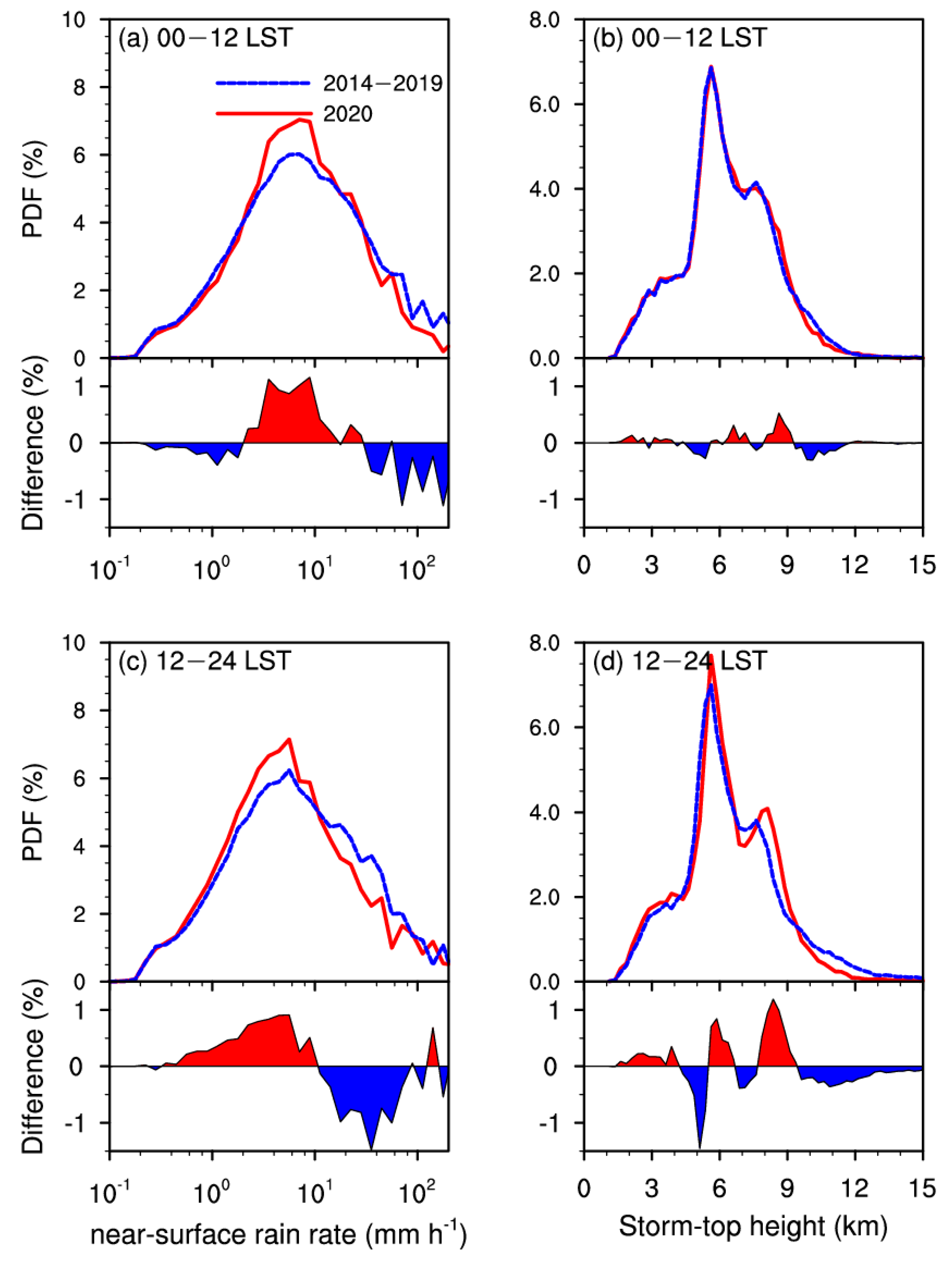
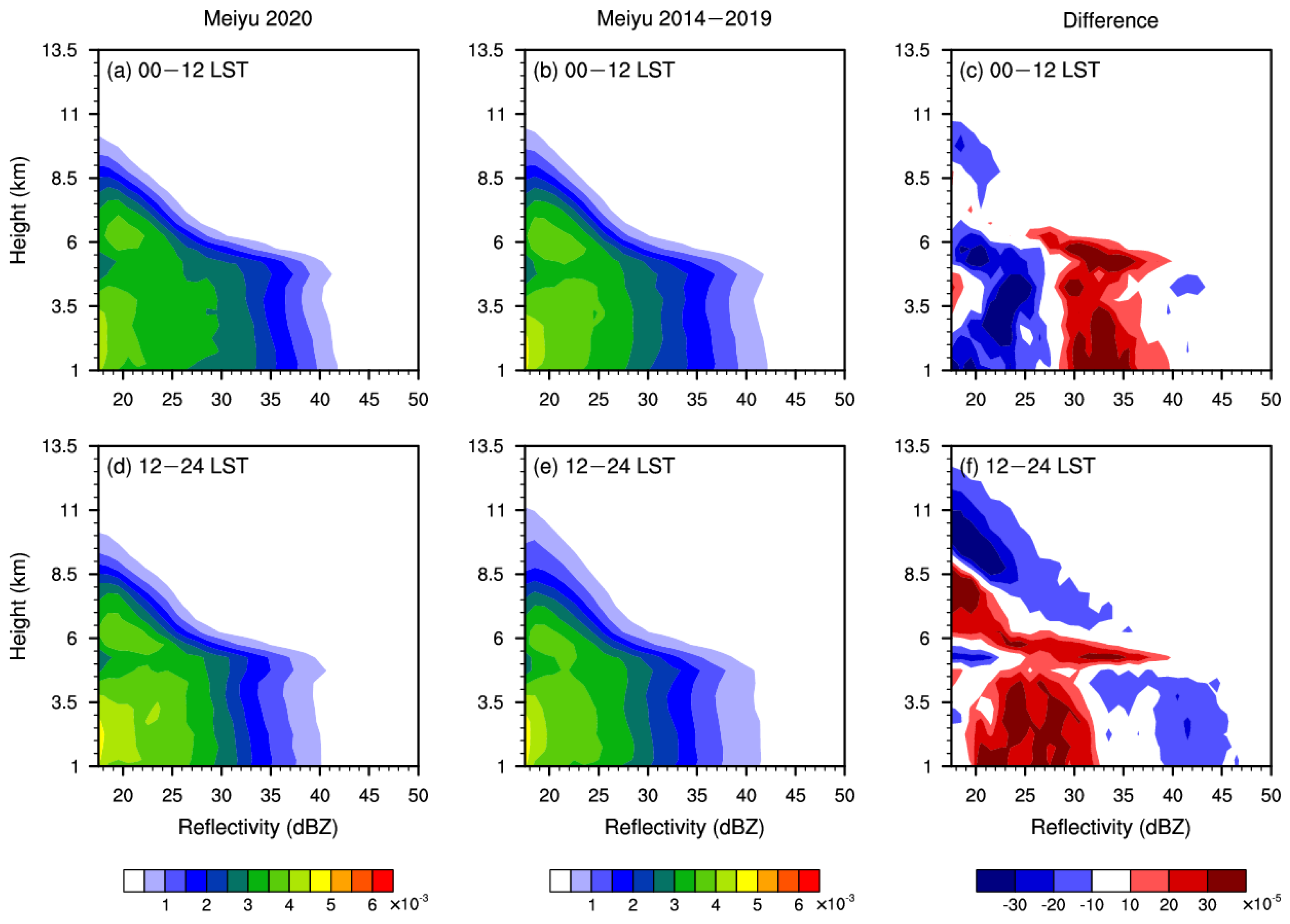

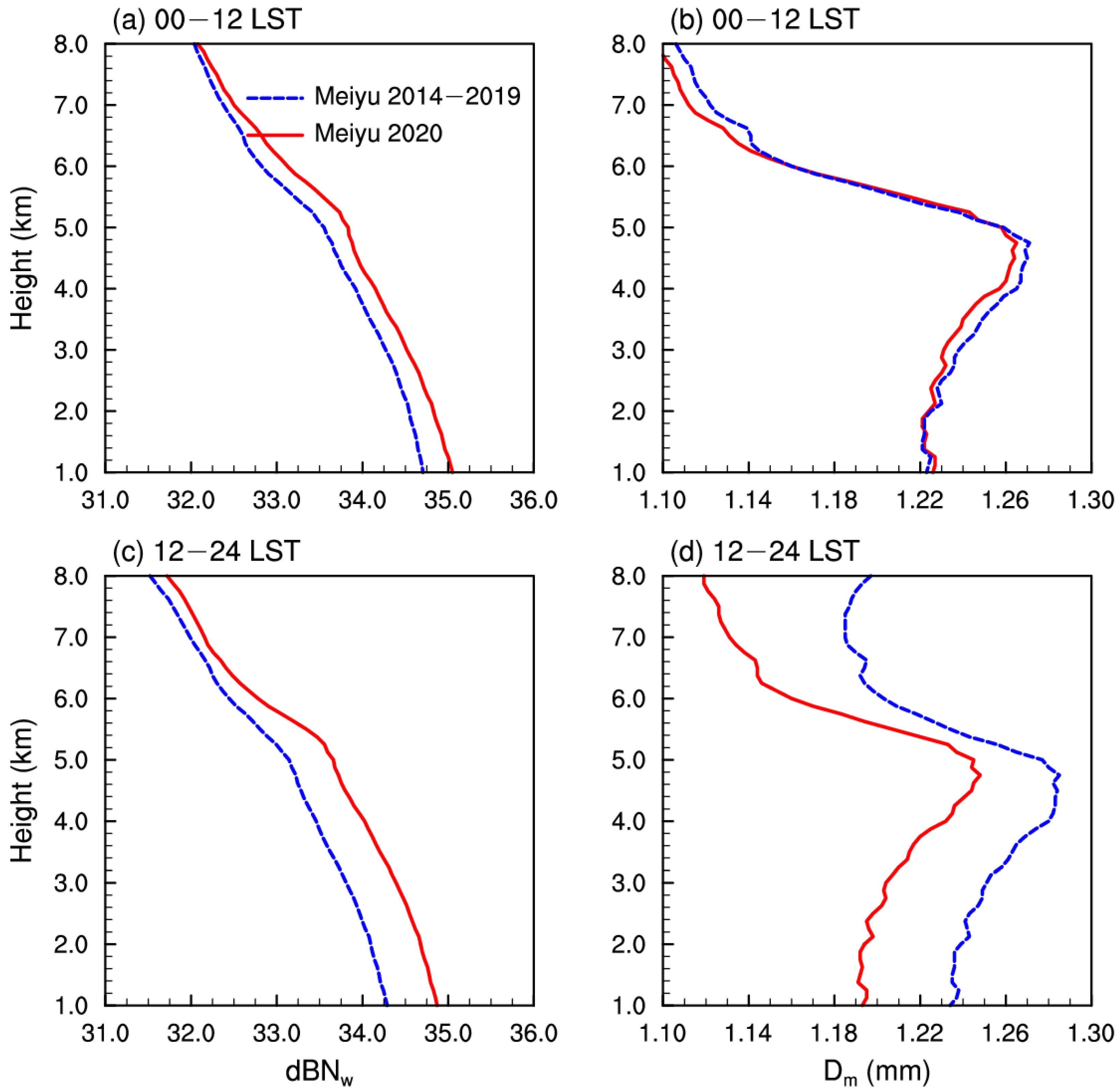
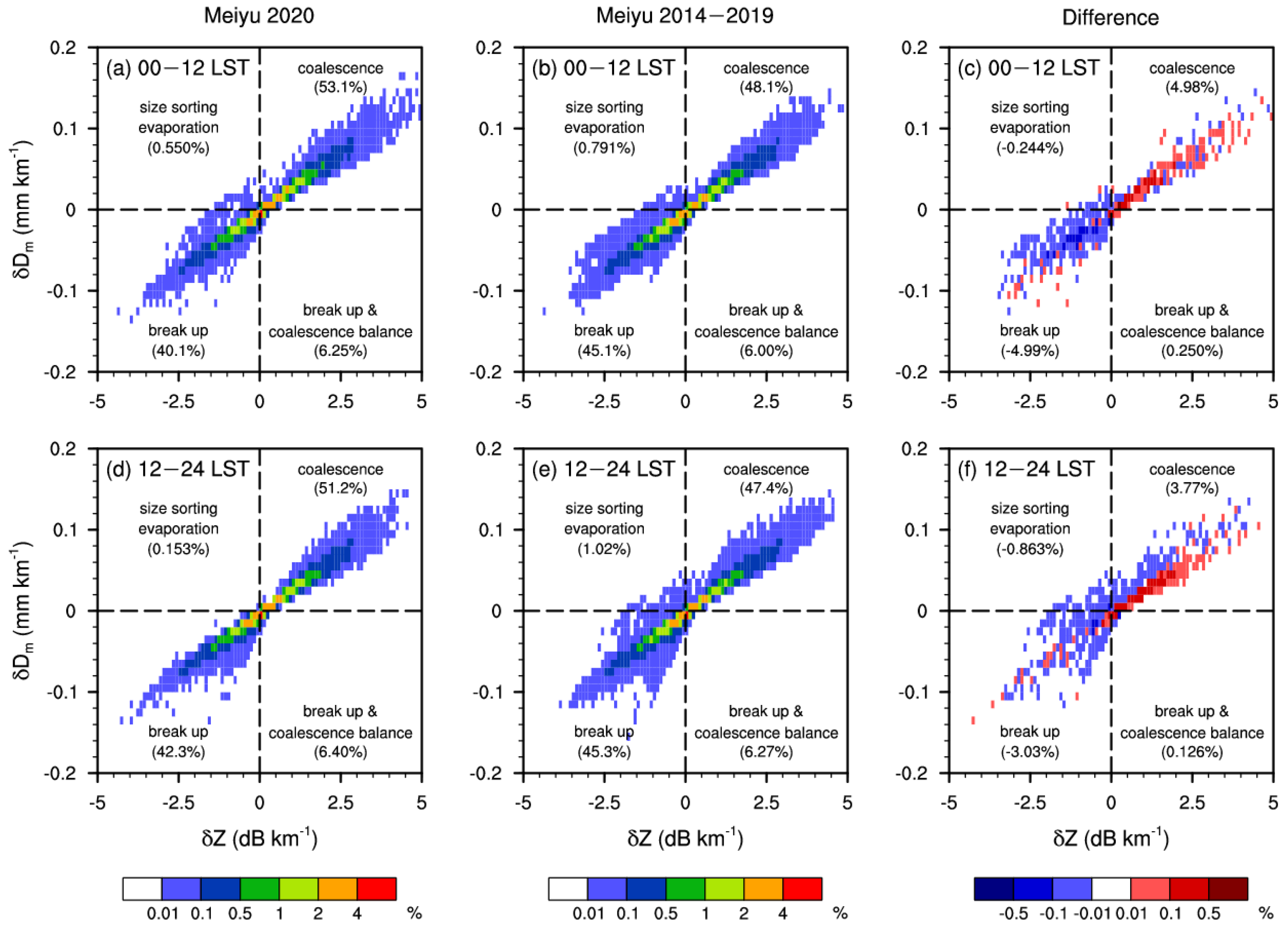
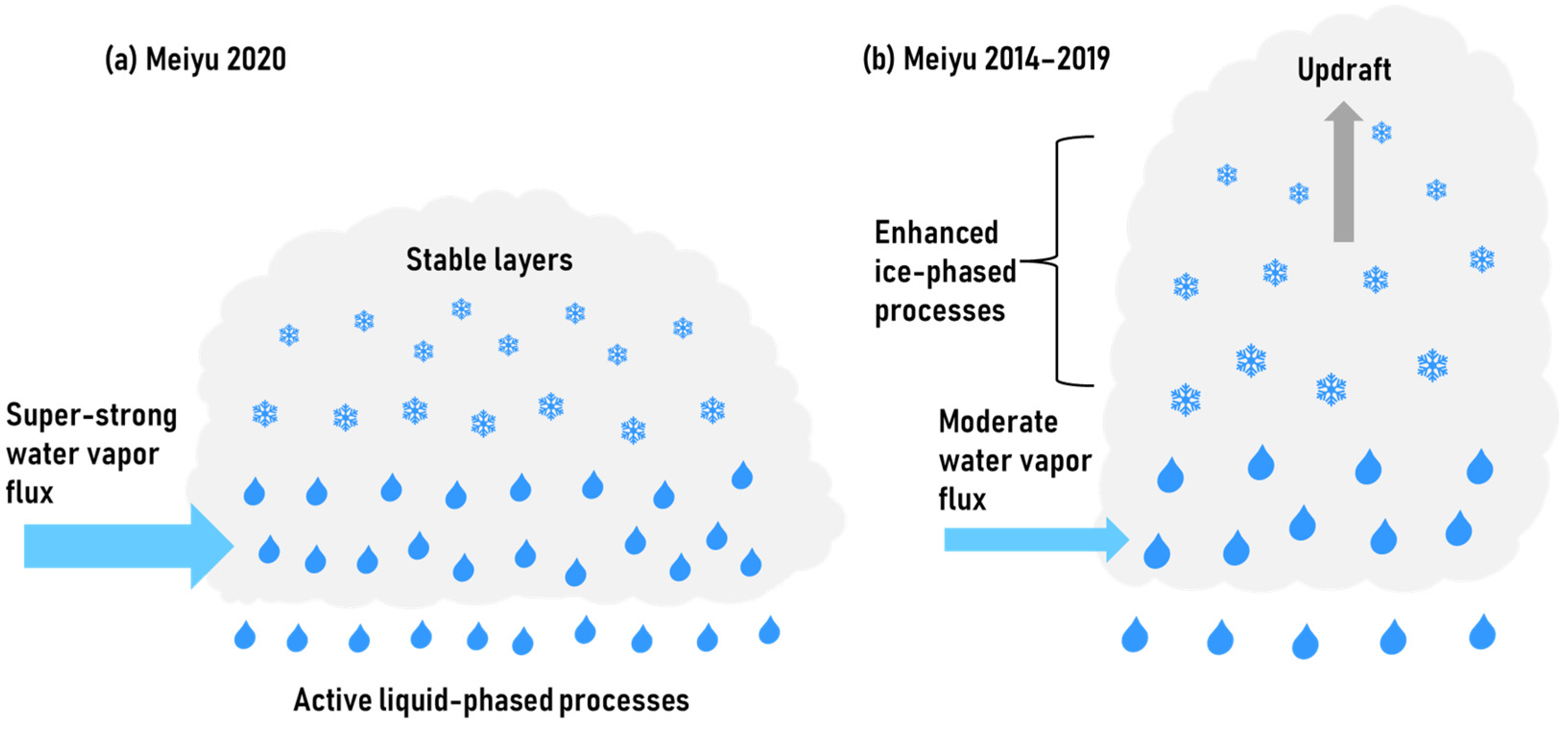
| Year | Onset Date | End Date | Duration (Days) |
|---|---|---|---|
| 2014 | 25 June | 5 July | 11 |
| 2015 | 24 June | 24 July | 31 |
| 2016 | 20 June | 21 July | 32 |
| 2017 | 30 June | 10 July | 11 |
| 2018 | 19 June | 11 July | 23 |
| 2019 | 17 June | 8 July | 22 |
| 2020 | 9 June | 31 July | 53 |
| 00–12 LST | 12–24 LST | ||||
|---|---|---|---|---|---|
| 2014–2019 | 2020 | 2014–2019 | 2020 | ||
| Total Sample Size | 70,737 | 29,444 | 72,832 | 41,881 | |
| Stratiform | ratio | 77.06% | 75.35% | 73.12% | 74.34% |
| RR (mm h−1) | 2.37 | 2.51 | 1.76 | 1.91 | |
| STH (km) | 6.80 | 6.80 | 6.78 | 6.84 | |
| Convective | ratio | 7.81% | 8.47% | 11.83% | 8.11% |
| RR (mm h−1) | 10.63 | 9.75 | 8.38 | 7.92 | |
| STH (km) | 7.67 | 7.61 | 8.70 | 7.82 | |
| Shallow | ratio | 14.18% | 15.42% | 13.97% | 16.84% |
| RR (mm h−1) | 1.20 | 1.29 | 1.26 | 1.28 | |
| STH (km) | 3.20 | 3.22 | 3.26 | 3.30 | |
Publisher’s Note: MDPI stays neutral with regard to jurisdictional claims in published maps and institutional affiliations. |
© 2022 by the authors. Licensee MDPI, Basel, Switzerland. This article is an open access article distributed under the terms and conditions of the Creative Commons Attribution (CC BY) license (https://creativecommons.org/licenses/by/4.0/).
Share and Cite
Zhang, A.; Chen, Y.; Zhou, S.; Chen, S.; Li, W. Precipitation Microphysics during the Extreme Meiyu Period in 2020. Remote Sens. 2022, 14, 1651. https://doi.org/10.3390/rs14071651
Zhang A, Chen Y, Zhou S, Chen S, Li W. Precipitation Microphysics during the Extreme Meiyu Period in 2020. Remote Sensing. 2022; 14(7):1651. https://doi.org/10.3390/rs14071651
Chicago/Turabian StyleZhang, Aoqi, Yilun Chen, Shengnan Zhou, Shumin Chen, and Weibiao Li. 2022. "Precipitation Microphysics during the Extreme Meiyu Period in 2020" Remote Sensing 14, no. 7: 1651. https://doi.org/10.3390/rs14071651
APA StyleZhang, A., Chen, Y., Zhou, S., Chen, S., & Li, W. (2022). Precipitation Microphysics during the Extreme Meiyu Period in 2020. Remote Sensing, 14(7), 1651. https://doi.org/10.3390/rs14071651









